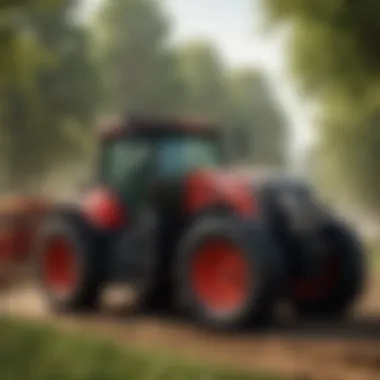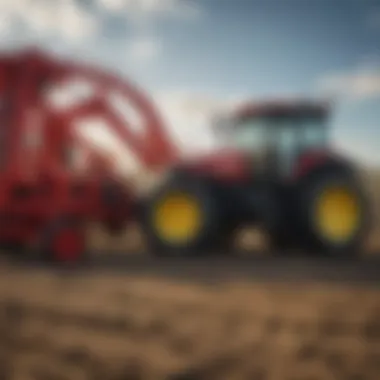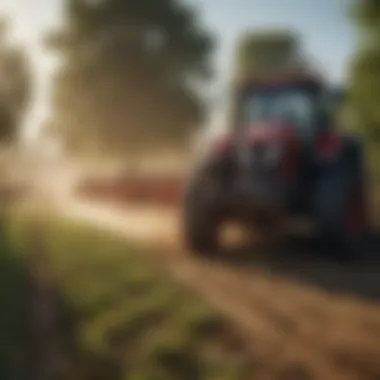Forrester's Farm Equipment: A Comprehensive Overview


Intro
Forrester's farm equipment is becoming increasingly significant in the realm of modern agriculture. With a focus on enhancing productivity and sustainability, this equipment showcases innovative features and technologies that support the evolving needs of farmers. Understanding the types, applications, and benefits of Forrester's products allows farmers and agriculture enthusiasts to make informed decisions, fostering better agricultural practices.
Overview of the Topic
Definition and Importance
Forrester's farm equipment encompasses a wide variety of machines and tools designed specifically for agricultural activities. This includes tractors, harvesters, tillage equipment, and precision farming tools. The importance of such equipment lies in its ability to improve efficiency, reduce labor, and promote sustainable farming practices. Modern farming demands precision, and Forrester's equipment meets this need, playing a crucial role in the economy by supporting both small and large-scale farms.
Current Trends
As the industry evolves, several trends are shaping the future of agricultural equipment:
- Automation: The movement toward automated machinery is gaining momentum, increasing precision and efficiency on farms.
- Sustainable Practices: There is a strong push for equipment that reduces environmental impact, such as tools that minimize soil disturbance.
- Data Integration: Smart farming tools, which utilize data analytics, are becoming common, enabling farmers to make real-time decisions based on accurate information.
Key Techniques and Practices
Step-by-Step Guide
Implementing Forrester's equipment effectively involves several steps:
- Assessment of Needs: Identify the specific requirements based on the type of farming being conducted.
- Selecting Equipment: Choose the appropriate machinery that aligns with both budget and operational goals.
- Training Operators: Ensure that all operators receive proper training to maximize efficiency and safety while using the equipment.
- Regular Maintenance: Establish a maintenance schedule to keep the equipment in optimal condition.
Tools and Equipment Needed
Farmers will find a range of tools indispensable:
- Tractors for general farming tasks.
- Seeders for planting.
- Harvesters and combines for efficient crop collection.
- Irrigation systems to manage water resources effectively.
Challenges and Solutions
Common Obstacles
While Forrester's equipment offers various benefits, there are challenges:
- High Initial Investment: Many farmers find the cost of modern equipment prohibitive.
- Technical Knowledge: Utilizing advanced technology can be daunting for some users.
Innovative Solutions
To tackle these issues, several strategies can be applied:
- Financing Options: Many manufacturers, including Forrester, provide financing solutions to spread out costs.
- Training Programs: Offering education on the use of complex machinery can improve user confidence and effectiveness.
"Understanding and utilizing modern farm equipment is essential for adapting to the fast-changing landscape of agriculture."
In summary, Forrester's farm equipment offers substantial benefits that can enhance farming practices. By employing the right techniques and addressing challenges with effective solutions, farmers can leverage these tools to improve both productivity and sustainability in agriculture.
Prologue to Forrester's Farm Equipment
Forrester's Farm Equipment plays a pivotal role in modern agriculture. As farming evolves, the equipment used becomes more essential. Advances in technology and sustainability push farmers to adopt tools that enhance productivity and efficiency. This section serves as a gateway to understand the significance of Forrester’s offerings and how they align with current agricultural needs.
Historical Context
To fully appreciate Forrester's Farm Equipment, it's important to look at its historical backdrop. The company originated in a time when agriculture was rapidly changing. Post-World War II, farmers began to seek efficient methods of production. Traditional farming techniques were often labor-intensive and time-consuming. The introduction of mechanized farming revolutionized agriculture. In this context, Forrester emerged as a key player, adapting to the industry's demands.
Over decades, Forrester has built a reputation based on innovation, reliability, and performance. Their commitment to enhancing farming practices reflects trends and user needs from the past to the present. They introduced equipment that not only helped increase yield but eased the physical burden on farmers. Today, they continue to draw from their rich history, enhancing their product lines to fit contemporary agricultural practices.
Mission and Vision
Forrester’s mission revolves around empowering farmers. They aim to provide equipment that is both cutting-edge and user-friendly. Their vision includes fostering sustainable farming practices. This focus addresses pressing environmental issues within agriculture. Through advanced technology, Forrester intends to enhance productivity while minimizing ecological impact.


The company’s goals align with broader trends in the industry, where sustainability is increasingly important. Forrester seeks to lead by example, integrating innovation that supports efficient resource use. They emphasize collaboration with farmers to understand their challenges, driving product development that is relevant and effective. By placing farmers' needs at the center of their mission, Forrester’s ensures that their equipment remains essential in agriculture.
Types of Forrester's Farm Equipment
Understanding the types of Forrester's farm equipment is crucial for farmers and agricultural enthusiasts. Different equipment serves specific functions in the farming process. Knowing which tools to use can greatly impact efficiency and productivity. The equipment can be broadly categorized into five main types: tractors, plows, harvesters, seeders and planters, and irrigation systems. Each type of equipment has unique benefits and considerations.
Tractors
Tractors are the backbone of modern farming. They provide the necessary power to perform various tasks. With different configurations, they can be used for plowing, tilling, and hauling. The durability and efficiency of Forrester's tractors are well noted. Selecting the right tractor can depend on factors such as farm size and types of crops grown.
- Types of Tractors: Forrester offers multiple models suited for various terrains.
- Horsepower: The range varies to accommodate small to large farms.
- Versatility: Many tractors can be outfitted with additional implements, enhancing their utility.
Plows
Plows are essential for soil management. They prepare the land for planting by turning and breaking up soil. Forrester’s plows excel in durability and design. Different styles, like moldboard and disk plows, serve distinct soil types.
- Importance of Plowing: Proper plowing improves aeration and soil fertility.
- Adjustability: Many of Forrester's plows are adjustable for various soil conditions.
Harvesters
Harvesters are vital during the harvest season. Forrester's harvesters combine multiple functions into one machine, boosting productivity. They can cut, thresh, and collect crops in a single operation.
- Efficiency: Using a harvester can significantly reduce time and labor costs.
- Crop Compatibility: Models are designed for a variety of crops like wheat and maize.
Seeders and Planters
Seeders and planters play a critical role in establishing crops. Forrester's equipment ensures accurate seed placement, which is vital for achieving uniform plant growth.
- Types of Seeders: Options range from manual to automated machines.
- Precision Planting: Enhances crop yields by minimizing seed wastage.
Irrigation Systems
Irrigation systems are indispensable for water management. Forrester's solutions include drip and sprinkler systems that optimize water usage for crop health.
- Water Efficiency: Precise irrigation can significantly reduce waste and improve yields.
- Technology Integration: Many systems can integrate with smart farming technologies, allowing for remote control and monitoring.
Applications of Forrester's Equipment
The application of Forrester's farm equipment is central to modern agricultural practices. This section explores various applications, shedding light on how these tools optimize farming operations. Understanding these applications allows farmers and agricultural enthusiasts to appreciate the value and versatility that Forrester's equipment brings to different farming scenarios. The following subsections detail key applications, illustrating benefits and considerations.
Crop Management
Effective crop management is crucial for maximizing yield and ensuring sustainability. Forrester's equipment simplifies numerous tasks within this domain. Tractors, for instance, enable rapid land preparation, making it easier to sow or plant crops. Additionally, precision planters reduce seed wastage by ensuring accurate seed placement and spacing.
Modern features such as automated seeding and fertilization help to ensure uniform growth, reducing the workload on farmers while increasing productivity. With the integration of data analytics, farmers can monitor crop health, evaluate soil conditions, and adjust strategies accordingly. This insight not only optimizes growth cycles but also supports better resource management, such as water and fertilizers.
Soil Preparation
Soil preparation is foundational to any successful farming operation. Forrester's offers a range of tools specifically designed for this task. For example, plows are essential for turning over soil, aerating it, and preparing it for planting. This process helps to break down compact layers, enhancing water infiltration and nutrient absorption in the soil.
Moreover, the use of rotary tillers further enriches soil quality. They mix organic matter into the soil, leading to improved fertility. Farmers are encouraged to adopt proper preparation techniques, as these practices not only increase productivity but also promote long-term soil health.
Irrigation and Water Management
Water management is a critical aspect of agriculture, especially in regions subject to drought or inconsistent rainfall. Forrester's irrigation systems address these issues effectively. Drip and sprinkler systems ensure efficient water usage, targeting the root zones of crops. This reduces water wastage and helps maintain optimal moisture levels in the soil.
Post-Harvest Handling
Post-harvest handling is often overlooked but remains pivotal in the agricultural process. Forrester's equipment plays a crucial role in preserving quality and reducing losses during this stage. Harvesters designed for efficiency ensure that crops are quickly gathered and stored properly, preserving their integrity.
Once harvested, the correct processing and transport are vital. Equipment such as conveyors and specialized bins facilitates smooth transitions from field to storage. Farmers can maintain product quality, which is essential for market success. By investing in robust post-harvest equipment, agricultural producers can minimize waste and enhance the economic viability of their operations.
Investing in durable and efficient farm equipment leads to increased productivity and better resource management.


In summary, the applications of Forrester's equipment span critical stages of the farming process. From crop management to post-harvest handling, these tools contribute to enhanced efficiency, sustainability, and productivity in agricultural practices.
Technological Innovations in Forrester's Equipment
The agricultural sector is rapidly evolving with the integration of new technologies. Forrester's farm equipment exemplifies this transition, showcasing innovations that enhance productivity, efficiency, and sustainability. Modern farming demands more than just traditional methods; it requires a systematic approach that incorporates cutting-edge technology. Through automation, data analytics, and IoT integration, Forrester's equipment is setting standards and leading the way in agricultural innovations.
Automation and Robotics
Automation in farming is not a mere trend; it is a necessity in optimizing labor and increasing output. Forrester's farm equipment utilizes automation to reduce manual tasks. Automating processes such as planting, watering, and harvesting leads to higher precision and reduced risk of errors.
For instance, robotic harvesters are designed to pick crops at the optimal time, ensuring the quality of produce remains high. These machines are equipped with sensors and cameras, enabling them to analyze and identify ripe fruits or vegetables effectively. This not only saves time but also minimizes labor costs.
Moreover, automating irrigation systems ensures that crops receive sufficient water without wasting resources. Timely and precise watering leads to healthier crops and maximizes yield.
"The future of agriculture lies in automation. Efficiency will dictate success in modern farming."
Data Analytics and Precision Farming
Data analytics plays a pivotal role in transforming farming into a science. Forrester's equipment incorporates sophisticated data collection tools that monitor various farm parameters. These can include soil moisture levels, weather conditions, and crop health.
Precision farming allows farmers to make informed decisions based on data analysis. For example, using drone technology, farmers can gather aerial data to assess crop health quickly. With this real-time feedback, they can adjust their strategies to improve crop yields.
Additionally, data analytics help determine the right amount of fertilizers and pesticides required, minimizing both costs and environmental impact. The use of predictive analytics often guides farmers in understanding the best time to plant or harvest crops, thereby increasing efficiency further.
Integration with IoT
The Internet of Things (IoT) represents a significant shift in how agriculture is conducted. Forrester's equipment seamlessly integrates with IoT technology, allowing various devices to communicate and share data. This interconnectedness brings a new level of responsiveness to farming operations.
Farmers can monitor their equipment remotely. This means that issues can be detected and addressed before they lead to significant problems. Sensors can report equipment performance and alert farmers to maintenance needs, reducing downtime.
IoT also enhances sustainability practices. Smart irrigation systems adjust based on weather forecasts and soil moisture properties, optimizing water usage. This greatly contributes to efficient farming that is considerate of resource conservation.
The merging of these technologies establishes a foundation for smarter agriculture, ensuring Forrester's farm equipment leads the way in innovation and efficiency.
Advantages of Using Forrester's Farm Equipment
Forrester's farm equipment offers numerous advantages that can significantly transform agricultural practices. Understanding these benefits is crucial for farmers and enthusiasts who seek to enhance their productivity, manage costs, and adopt more sustainable methods. This section delves into key elements such as increased productivity, cost efficiency, and sustainability practices related to Forrester's equipment.
Increased Productivity
One of the primary advantages of using Forrester's farm equipment is the marked increase in productivity. These machines are designed to operate at higher speeds and with greater precision than many older models. For example, Forrester's tractors are known for their powerful engines and advanced technologies, enabling farmers to complete tasks like plowing and planting in a fraction of the time.
Moreover, the implementation of automated features in harvesters streamlines the collection process, allowing farmers to gather crops more efficiently. This not only saves time but also mitigates the risks associated with manual labor, such as injuries or inefficiencies due to human error.
In essence, with the right equipment, farmers can optimize their workflows. This translates into larger yields and more effective use of time and resources, fundamentally changing the economics of farming.
Cost Efficiency
Cost efficiency is another significant factor to consider when evaluating Forrester's farm equipment. These machines, while often representing a substantial upfront investment, are built to last and maintain lower operational costs over time. For instance, Forrester's use of durable materials increases the lifespan of their products, reducing the need for frequent replacements.
In addition, many Forrester machines are designed with fuel efficiency in mind. Farmers can benefit from improved fuel consumption, which directly impacts the bottom line. This is particularly valuable in an industry where margins can be tight.
The technology integrated into Forrester's equipment can also lead to better resource management. For instance, precision farming techniques reduce waste of seeds, water, and fertilizers, contributing to further savings.
Sustainability Practices
Sustainability is increasingly becoming a focal point in agriculture, and Forrester's farm equipment plays a vital role in promoting environmentally friendly practices. The design of these machines often emphasizes reduced emissions and lower energy consumption. This is vital in an age where climate change remains a pressing concern.
For instance, advanced irrigation systems offered by Forrester allow for smart water management, minimizing runoff and conserving vital freshwater resources. Furthermore, their machinery often supports practices such as no-till farming, which preserves soil structure and prevents erosion.
By investing in sustainable equipment, farmers not only abide by legal and ethical standards, but they also contribute positively to the environment. This forward-thinking approach often aligns with consumer demand for sustainably sourced agricultural products, creating potential market advantages.
"Investing in Forrester's farm equipment is not just a business decision; it is a commitment to efficiency, sustainability, and the future of agriculture."


Maintenance and Care of Forrester's Equipment
Proper maintenance and care of Forrester's equipment are critical to ensuring that these machines operate efficiently and safely over time. Regular upkeep not only extends the lifespan of the equipment but also helps avoid costly repairs and downtime during crucial farming seasons. This section will delve into essential practices, troubleshooting techniques, and available support options to enhance the effectiveness of Forrester's equipment.
Regular Maintenance Practices
To maintain Forrester's equipment, farmers should integrate routine checks and servicing into their schedules. Here are some key practices to consider:
- Daily Inspections: Before use, operators should inspect machines for visible wear and tear. Checking tire pressure, fluid levels, and safety features is essential.
- Lubrication: Regular lubrication reduces friction and wear on moving parts. Use the recommended lubricants specific to each machine type, as outlined in the user manual.
- Fluid Changes: Change engine oil, hydraulic fluid, and coolant at intervals specified in the manufacturer's manual. Clean filters and replace them as required to ensure optimal performance.
- Cleaning: After each use, clean the equipment. Remove dirt, debris, and plant materials to prevent damage and rust. Pay particular attention to vital components like air filters and cooling systems.
These practices, while simple, require dedication and consistency. They result in better fuel efficiency and improved reliability of the equipment.
Troubleshooting Common Issues
Even with regular maintenance, issues may arise. Understanding some of the common problems and how to diagnose them can save both time and money:
- Engine Starting Trouble: If the machine does not start, check the battery connection and fuel levels. Sometimes, simple solutions like recharging the battery or replacing old fuel can resolve the issue.
- Hydraulic Problems: If there are leaks or the hydraulics do not respond, inspect the hoses for cracks or disconnects. Also, verify the fluid levels and replace any missing fluids.
- Overheating: Overheating may be caused by a blocked radiator or low coolant levels. Regularly clean radiators and ensure that the coolant is at the correct level.
Recognizing these issues early can prevent more serious problems from developing.
Service and Support Options
When issues go beyond routine maintenance or troubleshooting, accessing proper service and support becomes essential. Forrester’s offers several options:
- Manufacturer Support: Direct access to Forrester’s service team ensures that farmers receive qualified assistance. Their experts can guide through complex problems or schedule repairs.
- Local Dealers: Authorized dealers often provide repair services and parts. Building a relationship with a local provider can lead to faster service during peak times.
- Online Resources: Forrester’s website and forums like Reddit offer valuable information and community support for troubleshooting and maintenance tips.
In summary, investing time in the maintenance and care of Forrester's equipment leads to longer durability, reduced downtime, and ultimately increased productivity. Keeping machinery in optimal condition is crucial for the success of any agricultural operation.
The Future of Forrester's Farm Equipment
The future of Forrester's farm equipment holds significant importance for modern agriculture. As farming practices advance, both efficiency and sustainability play pivotal roles. Forrester's commitment to innovation positions it well to meet the challenges that lie ahead. It is not just about adapting to trends but also about leading them. This section will illuminate trends in agricultural technology and the role of sustainable agriculture in shaping the future of Forrester's offerings.
Trends in Agricultural Technology
Agricultural technology is evolving rapidly. Key trends impacting Forrester's future include:
- Precision Agriculture: This approach uses data and technology to ensure crops receive exactly what they need, reducing waste and enhancing yield. Sensors and drones become critical for monitoring fields, guiding decisions based on real-time information.
- Automation: With advances in robotics, Forrester’s equipment may increasingly integrate automated systems. This could lead to improved efficiency in tasks such as planting, watering, and harvesting. Farmers can use automated solutions to lower labor costs and focus on more strategic planning.
- Data-Driven Decision Making: The use of big data and analytics in agriculture will gain momentum. Forrester's will likely offer tools for analyzing farm data, helping farmers to make informed decisions that optimize crop health and resource use.
- Internet of Things (IoT): Connected devices will facilitate better communication between equipment and farmers. IoT can help monitor equipment performance, predict maintenance needs, and even track livestock.
These trends indicate a shift towards more technology-driven practices. It enhances productivity and sustainability, essential for dealing with population growth and climate change challenges.
The Role of Sustainable Agriculture
Sustainable agriculture is increasingly essential in the future of farming. This not only addresses environmental concerns but also responds to consumer preferences for eco-friendly produce. Forrester's farm equipment can play a significant role in promoting sustainability through:
- Resource Efficiency: Equipment designed with sustainable practices in mind can help maximize resource use. For instance, advanced irrigation systems minimize water waste while ensuring optimal crop health.
- Organic Farming Support: As organic farming gains traction, Forrester's can develop equipment tailored for organic practices. This includes tools that minimize soil disturbance and promote healthy ecosystems.
- Soil Health Management: Sustainable practices prioritize soil health. Forrester's may introduce tools that support cover cropping and rotational grazing, which enrich the soil and increase biodiversity.
- Reducing Carbon Footprint: With equipment designed for energy efficiency, Forrester's can help reduce the overall carbon footprint of farms. This aligns with global goals to combat climate change and promote sustainable practices.
“The future of agriculture lies at the intersection of technology and sustainability.”
In summary, the future of Forrester's farm equipment is set against a backdrop of technological advancements and a commitment to sustainability. Embracing these changes will ensure that Forrester remains relevant and continues to support farmers effectively in their efforts to produce food sustainably. As the agricultural sector evolves, so too will the equipment that farmers depend on.
End
In this article, we have detailed the multifaceted nature of Forrester's farm equipment, examining its contributions to modern agriculture. Understanding the importance of Forrester's offerings not only highlights their role in boosting productivity but also emphasizes sustainable practices. Farmers and agricultural enthusiasts benefit by integrating advanced tools into their operations, leading to improved crop yields and efficient resource management.
Summary of Key Points
The discussion provided a comprehensive overview of several critical aspects:
- Types of Equipment: From tractors to irrigation systems, Forrester's diverse range satisfies various agricultural needs.
- Applications in Farming: Emphasizing crop management and soil preparation, their equipment supports essential farm activities.
- Technological Innovations: Innovations like automation and IoT integration depict a future where equipment efficiently supports farmers.
- Advantages: Increase in productivity, implementing cost-effective methods, and enhancing sustainability practices are paramount benefits noted throughout.
- Maintenance: Understanding routine care and troubleshooting ensures longevity and efficiency in the equipment.
Overall, these key points help frame the significant impact of Forrester's equipment on modern farming practices.
Looking Ahead
The future of Forrester's farm equipment aligns with emerging trends in agricultural technology. One cannot overlook the increasing emphasis on sustainable agriculture, which influences the design and implementation of new tools. Future developments are likely to focus on:
- Enhanced automation capabilities that reduce labor requirements.
- Continued integration of data analytics for improved decision-making.
- Innovations aimed at minimizing environmental footprints while maximizing yields.
As the agricultural landscape evolves, Forrester's commitment to innovation and sustainability positions it to meet upcoming challenges effectively. Monitoring these trends will be essential for farmers seeking to stay at the forefront of efficient and responsible farming practices.



